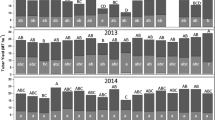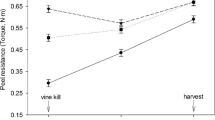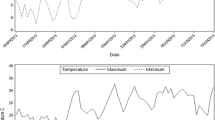Abstract
The quality of potato (Solanum tuberosum) tubers coming out of storage depends on the state of the tubers going into storage. Experiments determined the effects of vine-kill treatment and harvest date on the post-harvest physiology of potato tubers stored for up to 12 weeks. Potato cultivar Russet Burbank grown in central Wisconsin was harvested in late July when tubers were immature, in late August, and in early September after complete natural senescence of vines. Prior to the first two harvests, vines were either desiccated with diquat dibromide or were untreated. Data were collected at harvest and in storage for skin set, tuber respiration rate, and tuber sucrose, glucose, and fructose contents. Skin set at harvest was increased by use of the desiccant at the early harvest date, but not at the middle harvest date. Early harvest without vine kill resulted in elevated tuber bud-end glucose contents in storage. Early harvest with vine kill treatment resulted in increased rates of respiration in storage that persisted through December. Neither tuber sucrose nor glucose content 6 weeks after harvest was a good predictor of tuber glucose content 12 weeks after harvest. These data demonstrate that vine-kill treatment and tuber maturity at harvest have long-term effects on tuber quality.
Resumen
La calidad de los tubérculos de papa (Solanum tuberosum) saliendo del almacén, depende de la condición de los tubérculos cuando entran. Los experimentos determinaron los efectos del tratamiento para eliminación del follaje y fecha de cosecha en la fisiología de post-cosecha de tubérculos de papa almacenados hasta por 12 semanas. El cultivar Russet Burbank cultivado en la parte central de Wisconsin se cosechó a finales de julio, cuando los tubérculos eran inmaduros, a finales de agosto, y al principio de septiembre, después de completar la senescencia natural del follaje. Antes de las primeras dos cosechas, el follaje se desecó con dibromuro de diquat o sin desecante. Se tomaron datos a la cosecha y en el almacén para madurez de la piel, nivel respiratorio del tubérculo, y para el contenido de sacarosa, glucosa y fructosa. La madurez de la piel se incrementó con el uso del desecante en la fecha temprana de cosecha, mas no en la intermedia. La cosecha temprana sin la eliminación del follaje dio por resultado un contenido elevado de glucosa en el extremo apical del tubérculo en almacén. La cosecha temprana con el tratamiento de eliminación del follaje resultó en niveles elevados de respiración en el almacén que persistieron hasta diciembre. Ni el contenido de la sacarosa ni el de glucosa del tubérculo, seis semanas después de la cosecha, fueron buenos indicadores del contenido de glucosa doce semanas después de la cosecha. Estos datos demuestran que el tratamiento de eliminación del follaje y la madurez del tubérculo a la cosecha, tienen efecto a largo plazo en la calidad del tubérculo.





Similar content being viewed by others
References
Bethke, P.C., R. Sabba, and A.J. Bussan. 2009. Tuber water and pressure potentials decrease and sucrose contents increase in response to moderate drought and heat stress. American Journal of Potato Research 86: 519–532.
Burton, W. 1974. The oxygen uptake, in air and in 5% O2, and the carbon dioxide output, of stored potato tubers. Potato Research 17: 113–137.
Burton, W.G. 1978. Post-harvest behaviour and storage of potatoes. In Applied biology, ed. T. H. Coaker, 86–228. Academic.
Bussan, A. J., R. P. Sabba, and M. J. Drilias. 2009. Tuber maturation and potato storability: Optimizing skin set, sugars and solids. University of Wisconsin-Extension, Cooperative Extension. Bulletin #A3884-02.
Driskill, E.P., L.O. Knowles, and N.R. Knowles. 2007. Temperature-induced changes in potato processing quality during storage are modulated by tuber maturity. American Journal of Potato Research 84: 367–383.
Granda, C., R. Moreira, and E. Castell-Perez. 2005. Effect of raw potato composition on acrylamide formation in potato chips. Journal of Food Science 70: E519–E525.
Haderlie, L., J. Halderson, P. Leino, P. Petersen, and R. Callihan. 1989. Chemical desiccation of potato vines. American Potato Journal 66: 53–62.
Halderson, J., and R. Henning. 1993. Measurements for determining potato tuber maturity. American Potato Journal 70: 131–141.
Iritani, W.M., and L.D. Weller. 1977. Changes in sucrose and reducing sugar contents of Kennebec and Russet Burbank during growth and post harvest holding temperatures. American Potato Journal 54: 494–495.
Ivany, J., and J. Sanderson. 2001. Response of potato (Solanum tuberosum) cultivars to glufosinate-ammonium and diquat used as desiccants. Weed Technology 15: 505–510.
Kempenaar, C., and P.C. Struik. 2007. The canon of potato science: 33. Haulm Killing. Potato Research 50: 341–345.
Knowles, N.R., E.R. Driskill, and L.O. Knowles. 2009. Sweetening responses of potato tubers of different maturity to conventional and non-conventional storage temperature regimes. Postharvest Biology and Technology 52: 49–61.
Kolbe, H., and S. Stephan-Beckmann. 1997. Development, growth and chemical composition of the potato crop (Solanum tuberosum L.).2. Tuber and whole plant. Potato Research 40: 135–153.
Kumar, D., B. Singh, and P. Kumar. 2004. An overview of the factors affecting sugar content of potatoes. Annals of Applied Biology 145: 247–256.
Lulai, E., and D. Corsini. 1998. Differential deposition of suberin phenolic and aliphatic domains and their roles in resistance to infection during potato tuber (Solanum tuberosum L.) wound-healing. Physiological and Molecular Plant Pathology 53: 209–222.
Lulai, E., and P. Orr. 1994. Techniques for detecting and measuring developmental and maturational changes in tuber native periderm. American Potato Journal 71: 489–505.
Lulai, E.C., and P.H. Orr. 1993. Determining the feasibility of measuring genotypic differences in skin-set. American Potato Journal 70: 599–609.
Miller, R., J. Harrington, and G. Kuhn. 1975. Effect of variety and harvest date on tuber sugars and chip color. American Potato Journal 52: 379–386.
Murphy, H.J. 1968. Potato vine killing. American Potato Journal 45: 472–478.
Nelson, D., and R. Shaw. 1976. Effect of planting and harvest dates, location in hill and tuber size on sugar content of Kennebec potatoes. American Potato Journal 53: 15–21.
Nelson, D.C., and J. Sowokinos. 1983. Yield and relationships among tuber size, sucrose and chip color in 6 potato cultivars on various harvest dates. American Potato Journal 60: 949–958.
Pavlista, A.D. 2002. Skin set evaluation by skin shear measurements. American Journal of Potato Research 79: 301–307.
Pedreschi, F., K. Kaack, and K. Granby. 2006. Acrylamide content and color development in fried potato strips. Food Research International 39: 40–46.
Pisarczyk, J. 1982. Field harvest damage affects potato tuber respiration and sugar content. American Potato Journal 59: 205–211.
Pritchard, M., and L. Adam. 1992. Preconditioning and storage of chemically immature Russet Burbank and Shepody potatoes. American Potato Journal 69: 805–815.
Renner, K. 1991. Chemical vine desiccation of 2 potato cultivars. American Potato Journal 68: 479–491.
Sabba, R.P., A.J. Bussan, B.A. Michaelis, R. Hughes, M.J. Drilias, and M.T. Glynn. 2007. Effect of planting and vine-kill timing on sugars, specific gravity and skin set in processing potato cultivars. American Journal of Potato Research 84: 205–215.
Schippers, P.A. 1977a. Rate of respiration of potato tubers during storage.1. Review of literature. Potato Research 20: 173–188.
Schippers, P.A. 1977b. Rate of respiration of potato tubers during storage.2. Results of experiments in 1972 and 1973. Potato Research 20: 189–206.
Silva, E.M., and P.W. Simon. 2005. Genetic, physiological, and environmental factors affecting acrylamide concentration in fried potato products. Advances in Experimental Medicine and Biology 561: 371–386.
Sowokinos, J. 1971. Relationship of sucrose synthetase cleavage activity to chemical and physical maturity of Norchip and Kennebec potatoes. American Potato Journal 48: 37–46.
Sowokinos, J. 1973. Maturation of Solanum tuberosum. 1. Comparative sucrose and sucrose synthetase levels between several good and poor processing varieties. American Potato Journal 50: 234–247.
Sowokinos, J.R. 1978. Relationship of harvest sucrose content to processing maturity and storage life of potatoes. American Potato Journal 55: 333–344.
Stadler, R.H., I. Blank, N. Varga, F. Robert, J. Hau, P.A. Guy, M.C. Robert, and S. Riediker. 2002. Acrylamide from Maillard reaction products. Nature 419: 449–450.
Stark, J.C., and S.L. Love. 2003. Potato production systems. University of Idaho Agricultural Communications, Moscow, ID.
Thompson, A.L., S.L. Love, J.R. Sowokinos, M.K. Thornton, and C.C. Shock. 2008. Review of the sugar end disorder in potato (Solanum tuberosum, L.). American Journal of Potato Research 85: 375–386.
Vainio, H. 2003. Acrylamide in heat-processed foods—a carcinogen looking for human cancer? European Journal of Epidemiology 18: 1105–1106.
Waterer, D. 2007. Vine desiccation characteristics and influence of time and method of top kill on yields and quality of four cultivars of potato (Solanum tuberosum L.). Canadian journal of plant science 87: 129–135.
Acknowledgements
This research was funded in part by the Wisconsin Potato and Vegetable Growers Association whose support is gratefully acknowledged. The authors thank the staff at the Hancock Agricultural Research Station for their help with planting, crop management, and harvest, and Nathan Weyenberg for assistance in the field and in preparing samples for HPLC analysis. The experiments described comply with the laws of the United States of America. The authors have no financial interest with the organization that sponsored the research.
Disclaimer
Mention of company or trade name does not imply endorsement by the United States Department of Agriculture or others not named.
Author information
Authors and Affiliations
Corresponding author
Rights and permissions
About this article
Cite this article
Bethke, P.C., Busse, J.S. Vine-Kill Treatment and Harvest Date have Persistent Effects on Tuber Physiology. Am. J. Pot Res 87, 299–309 (2010). https://doi.org/10.1007/s12230-010-9137-4
Published:
Issue Date:
DOI: https://doi.org/10.1007/s12230-010-9137-4




